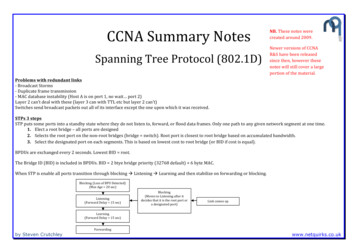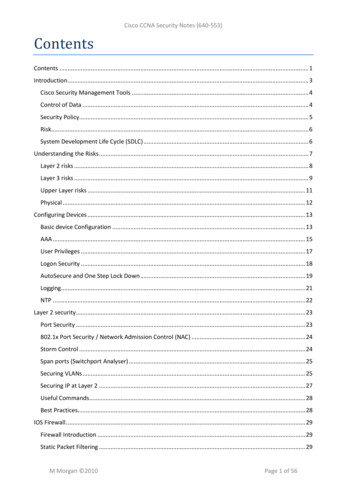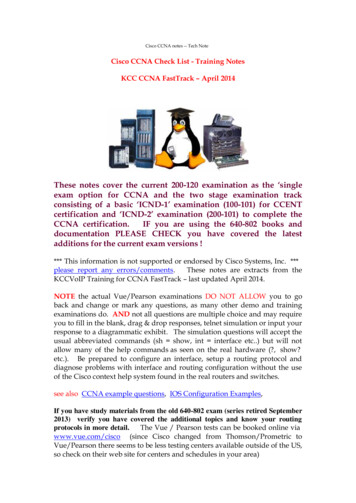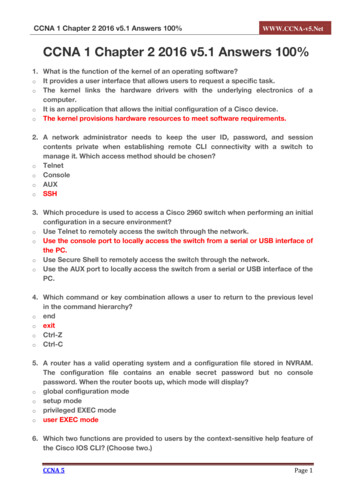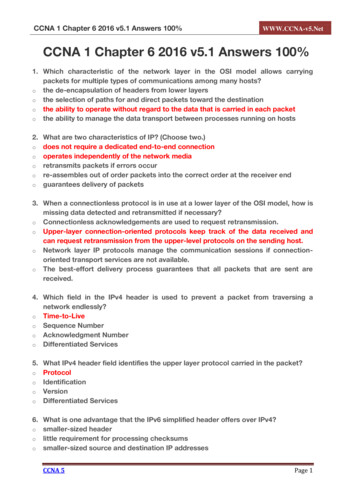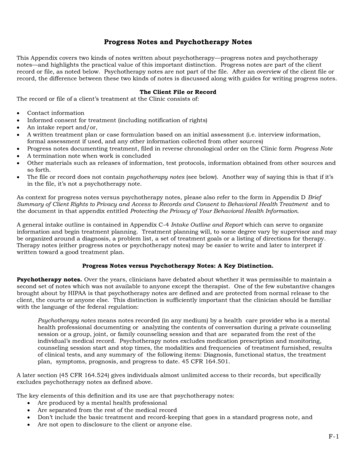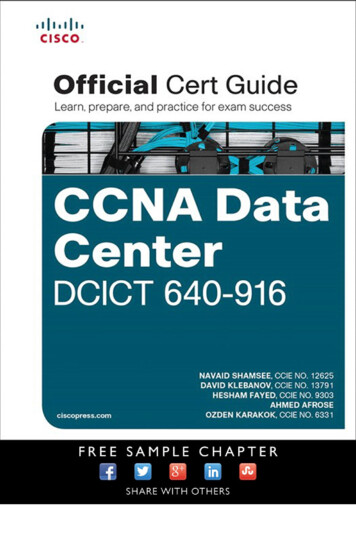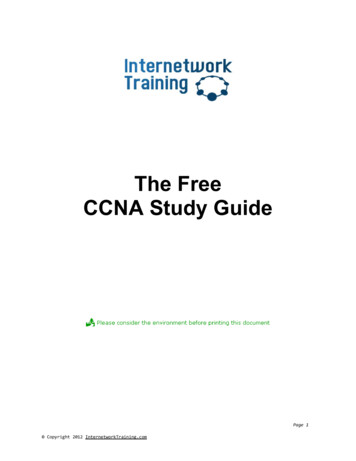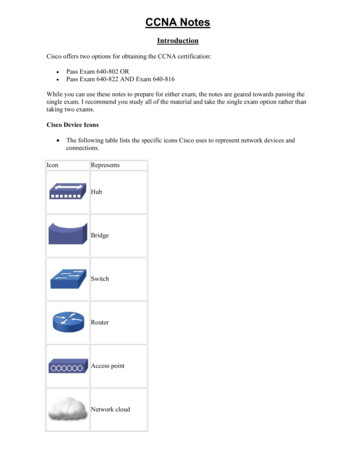
Transcription
CCNA NotesIntroductionCisco offers two options for obtaining the CCNA certification: Pass Exam 640-802 ORPass Exam 640-822 AND Exam 640-816While you can use these notes to prepare for either exam, the notes are geared towards passing thesingle exam. I recommend you study all of the material and take the single exam option rather thantaking two exams.Cisco Device Icons IconThe following table lists the specific icons Cisco uses to represent network devices ss pointNetwork cloud
Ethernet connectionSerial LineconnectionWireless connectionVirtual Circuit
The OSI ModelAs you study this section, answer the following questions: What is the OSI model and why is it important in understanding networking?How does the third OSI model layer relate to administering routers?Which OSI model layer is concerned with MAC addresses?What protocols correspond to the Presentation and Session layers?What is the difference between the TCP and UDP protocols?What is the EIA/TIA 232 protocol concerned with?This section covers the following exam objectives: 103. Use the OSI and TCP/IP models and their associated protocols to explain how dataflows in a network105. Describe the purpose and basic operation of the protocols in the OSI and TCP models110. Identify and correct common network problems at layers 1, 2, 3 and 7 using a layeredmodel approachOSI Model FactsThe OSI model classifies and organizes the tasks that hosts perform to prepare data for transportacross the network. You should be familiar with the OSI model because it is the most widely usedmethod for understanding and talking about network communications. However, remember that itis only a theoretical model that defines standards for programmers and network administrators, nota model of actual physical layers.Using the OSI model to discuss networking concepts has the following advantages: Provides a common language or reference point between network professionalsDivides networking tasks into logical layers for easier comprehensionAllows specialization of features at different levelsAids in troubleshootingPromotes standards interoperability between networks and devicesProvides modularity in networking features (developers can change features withoutchanging the entire approach)However, you must remember the following limitations of the OSI model. OSI layers are theoretical and do not actually perform real functions.Industry implementations rarely have a layer-to-layer correspondence with the OSI layers.Different protocols within the stack perform different functions that help send or receive theoverall message.A particular protocol implementation may not represent every OSI layer (or may spreadacross multiple layers).To help remember the layer names of the OSI model, try the following mnemonic devices:LayerNameMnemonicMnemonic(Bottom to top) (Top to bottom)Layer 7 Application AwayLayer 6 Presentation PizzaAllLayer 5 SessionSeemSausagePeople
Layer 4 TransportLayer 3 NetworkThrowToNotNeedLayer 2 Data LinkLayer 1 PhysicalDoDataPleaseProcessingHave some fun and come up with your own mnemonic for the OSI model, but stick to just one soyou don't get confused.Lower OSI Layer FactsThe following table summarizes basic characteristics of the lower OSI model layers.LayerDescriptionPhysicalThe Physical layer of the OSI model sets standards for sending and receivingelectrical signals between devices. It describes how digital data (bits) areconverted to electric pulses, radio waves, or pulses of lights.Devices that operate at the physical layer send and receive a stream of bits.The Media Access Control (MAC) layer defines specifications for controllingaccess to the media. The MAC sublayer is responsible for:MediaAccessControl(MAC) Adding frame start and stop information to the packetAdding Cyclical Redundancy Check (CRC) for error checkingConverting frames into bits to be sent across the networkIdentifying network devices and network topologies in preparation formedia transmissionDefining an address (such as the MAC address) for each physical deviceon the networkControlling access to the transmission mediumThe Logical Link Control (LLC) layer provides an interface between the MAClayer and upper-layer protocols. LLC protocols are defined by the IEEE 802.2committee. The LLC sublayer is responsible for:DataLink LogicalLinkControl(LLC) Maintaining orderly delivery of frames through sequencingControlling the flow or rate of transmissions using the following:o Acknowledgementso Bufferingo WindowingEnsuring error-free reception of messages by retransmittingConverting data into an acceptable form for the upper layersRemoving framing information from the packet and forwarding themessage to the Network layerProvide a way for upper layers of the OSI model to use any MAC layerprotocolDefining Service Access Points (SAPs) by tracking and managingdifferent protocolsThe Network layer describes how data is routed across networks and on to thedestination. Network layer functions include:Network Maintaining addresses of neighboring routers.Maintaining a list of known networks.
Determining the next network point to which data should be sent. Routersuse a routing protocol to take into account various factors such as thenumber of hops in the path, link speed, and link reliability to select theoptimal path for data.Packets forwarded from the Transport to the Network layer become datagramsand network-specific (routing) information is added. Network layer protocolsthen ensure that the data arrives at the intended destinations.The Transport layer provides a transition between the upper and lower layers ofthe OSI model, making the upper and lower layers transparent from each other. Upper layers format and process data without regard for deliveryLower layers prepare the data for delivery by fragmenting and attachingtransport required informationTransport layer uses the following: Transport Port (or socket) numbers are used to identify distinct applications runningon the same system. This allows each host to provide multiple services.The Transport layer receives large packets of information from higherlayers and breaks them into smaller packets called segments.Segmentation is necessary to enable the data to meet network size andformat restrictions.The receiving Transport layer uses packet sequence numbers toreassemble segments into the original message.Connection-oriented protocols perform error detection and correction andidentify lost packets for retransmission. A connection-oriented protocol isa good choice where:o Reliable, error-free communications are more important thanspeedo Larger chunks of data are being sentConnectionless services assume an existing link between devices andallow transmission without extensive session establishment.Connectionless communications use no error checking, sessionestablishment, or acknowledgements. Connectionless protocols allowquick, efficient communication at the risk of data errors and packet loss.Connectionless protocols are a good choice where:o Speed is importanto Smaller chunks of data are being sentUpper OSI Model Layer FactsThe following table summarizes basic characteristics of the upper OSI model layers.LayerDescriptionThe Application layer integrates network functionality into the host operating system,and enables network services. The Application layer does not include specificapplications that provide services, but rather provides the capability for services tooperate on the network. These services include:Application File services--transferring, storing, and updating shared dataPrint services--enabling network printers to be shared by multiple usersMessage services--transferring data in many formats (text, audio, video) fromone location to another, or from one user to another
Application services--sharing application processing throughout the networkand enabling specialized network servers to perform processing tasksDatabase services--storing, retrieving, and coordinating database informationthroughout the networkThe Application layer specifies many important network services that are used on theInternet. These include: HTTPTelnetFTPTFTPSNMPNote: Most Application layer protocols operate at multiple layers down to the Sessionand even Transport layers. However, they are classified as Application layer protocolsbecause they start at the Application layer (the Application layer is the highest layerwhere they operate).The Presentation layer formats or "presents" data into a compatible form for receipt bythe Application layer or the destination system. Specifically, the Presentation layerensures: Presentation Formatting and translation of data between systemsNegotiation of data transfer syntax between systems, through convertingcharacter sets to the correct format.Compatibility with the hostEncapsulation of data into message envelopes by encryption and compressionRestoration of data by decryption and decompressionThe Presentation layer formats data for the Application layer. Therefore, it also setsstandards for multimedia and other file formats. These include standard file formatssuch as: JPEG, BMP, TIFF, PICTMPEG, WMV, AVIASCII, EBCDICMIDI, WAVThe Session layer's primary function is managing the sessions in which data istransferred. Functions at this layer may include: Session Establishment and maintenance of communication sessions between thenetwork hosts, ensuring that data is transported.Management of multiple sessions (each client connection is called a session).A server can concurrently maintain thousands of sessions.Assignment of the session ID number to each session, which is then used bythe Transport layer to properly route the messages.Dialog control--specifying how the network devices coordinate with eachother (simplex, half-duplex, and full-duplex).Termination of communication sessions between network hosts uponcompletion of the data transfer.The Session layer protocols and interfaces coordinate requests and responses betweendifferent hosts using the same application. These protocols and interfaces include:
Network File System (NFS)Apple Session Protocol (ASP)Structured Query Language (SQL)Remote procedure call (RPC)X Window OSI Layer ReviewThe following table compares the functions performed at each OSI model layer.LayerDescription and Keywords ApplicationPresentation Provides an interface for aservice to operateCommunication partneridentificationData format (file formats)Encryption, translation, andcompressionData format and exchangeProtocols HTTPTelnetFTPTFTPSNMP JPEG,BMP,TIFF,PICTMPEG,WMV,AVIASCII,EBCDICMIDI,WAV Session Transport Network Keeps data streams separate(session identification)Set up, maintain, and teardown communicationsessionsReliable (connectionoriented) and unreliable(connectionless)communicationsEnd-to-end flow controlPort and socket numbersSegmentation, sequencing,and combinationLogical addressesPath determination(identification and selection)Routing packets SQLNFSASPRPCXwindow TCP(connectionoriented)UDP(connectionless) ationand dataDataDataSegments RoutersLayer 3switchesPackets
LogicalLinkControl(LLC)DataLin Medik aAccessControl(MAC) Convert bits into bytes andbytes into framesMAC address, hardwareaddressLogical network topologyMedia accessFlow controlo Acknowledgementso Bufferingo WindowingParity and CRC LANprotocols: 802.2(LLC),802.3(Ethernet), 802.5(TokenRing),802.11(Wireless)WANprotocols: HDLC,PPP,FrameRelay,ISDN,ATM Physical Move bits across mediaCables, connectors, pinpositionsElectrical signals (voltage,bit synchronization)Physical topology (networklayout) 5RJ45 NetworkInterfaceCard (NIC)transceivers FramesSwitchBridgeTransmissionmedia (cable andwires)MediaconnectorsTransceivers (includingtransceiversbuilt SUsWirelessAccessPoints
TCP/IPAs you study this section, answer the following questions: How does the DOD model correspond to the OSI model?Which TCP/IP protocols allow for copying and moving files?What does the Telnet protocol allow you to do?Which protocol includes a set of messages that controls how data moves through a network?What is the role of the subnet mask?What is the default address class of the IP address 132.11.166.5?What three address ranges are used for private IP addresses?What is the broadcast address of network 132.11.0.0?This section covers the following exam objectives: 103. Use the OSI and TCP/IP models and their associated protocols to explain how dataflows in a network104. Describe common networked applications including web applications105. Describe the purpose and basic operation of the protocols in the OSI and TCP models106. Describe the impact of applications (Voice Over IP and Video Over IP) on a network301. Describe the operation and benefits of using private and public IP addressingTCP/IP Protocol Suite FactsGroups of protocols (called protocol suites or protocol stacks) are designed to interact and be usedtogether. The TCP/IP protocol suite is used on the Internet and on most networks. Nearly allcomputers today use TCP/IP protocols for communication because it is highly scalable androutable. When learning about TCP/IP protocols, it is common to use a theoretical layered modelcalled the TCP/IP model (also known as the Department of Defense (DoD) model). The layers ofthe DoD model are as follows: The Application layer (also called the Process layer) corresponds to the Session,Presentation, and Application layers of the OSI model.The Host-to-host layer is comparable to the Transport layer of the OSI model and isresponsible for error checking and reliable packet delivery. Here, the data stream is brokeninto segments that must be assigned sequence numbers so that the segments can b
CCNA Notes Introduction Cisco offers two options for obtaining the CCNA certification: Pass Exam 640-802 OR Pass Exam 640-822 AND Exam 640-816 While you can use these notes to prepare for either exam, the notes are geared towards passing the single exam. I recommend you study all of the material and take the single exam option rather than taking two exams. Cisco Device Icons The following .
